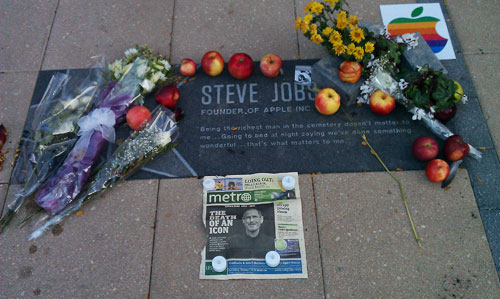I don’t know that much about Apple. The only gemba I’ve visited are lots of Apple stores (I don’t know if they’re lean but they go far in solving customers’ problems) and a few (far from lean) suppliers in East Asia.

Since his death, comparisons of Steve Jobs with great innovators and industrialists have been plentiful, with Thomas Edison and Henry Ford mentioned most often. The Edison comparison is off the mark, since I consider Edison as an inventor first, and businessman second, with little interest nor aptitude for working the bridge between his inventions and commercialization.
Though known as innovators, the secret to the success of Jobs and Ford was not that they actually invented anything like light bulbs. Ford didn’t invent the automobile. Nor did he really invent the idea of flow production or interchangeable parts. Likewise, Jobs didn’t invent the PC, the graphical interface, the music player, music, the telephone, the tablet PC. What Jobs did, like Henry before him, was put it all together as a total package. And the packages they developed were innovative and complete beyond imagination.
Instructive parallels between Jobs and Ford come easily. Ford’s critical role in the history of lean thinking is well established – he was the first to achieve sustained flow production on a big scale and flow production is the operational aim of any lean operating system. Ford became the richest, most famous industrialist of his time through introducing a breakthrough product. But, what was truly revolutionary about Ford’s achievement was that he packaged his breakthrough product with an even greater breakthrough production process and business model.
Both men were also renowned for their infamous flaws. Demanding, abusive, confident to the point of being dismissive of the views of others – not exactly embodying the all-important lean principle of “respect for people.”
Jobs and Ford shared an unrelenting pursuit of improvement – as long as they were in charge. Daily kaizen practiced by everyone was a hallmark of the approach of neither; they didn’t necessarily value the views of the little man, certainly not of the workers who built their products. Ford is applauded for supporting his workforce through such grand actions as instituting his famous $5 per day pay and establishing the Ford English School to provide his workers with needed education. But those moves – while completely laudable – were mostly self-serving (nothing wrong with that, of course). He needed to attract workers in numbers never before seen. He had done the math and knew he would have no problem paying the unprecedented day rate. The fact that the workers could then afford the products they produced was a nice plus. As for the school – workers learned English and even American manners so they could be better citizens – from Ford’s standpoint he was able to attract new (documented, I wondered?) immigrants to work effectively on his assembly lines.
One of the more interesting parallels between the two men can be found in their supply chain thinking. Ford became the most famous proponent of extreme vertical integration. Vertical integration was in Ford’s view a way to extend flow from end to end. Note, however, that Ford never extended the integration to dealers, as Jobs later did.
Similarly, Jobs famously kept far more operations in-house than anyone in his industry. He did hardware design, software, operating systems, web services, consumer devices, even retail, insisting on seamless integration throughout. And he held to that approach during an era when it was thoroughly discredited within his industry, and beyond, a time when academic theorists, consultants, and industry practitioners all preached the virtues of greater outsourcing of operations to focus instead on a few core competencies. (Interestingly, the Macintosh was first produced at a new state-of-the-art facility – reportedly using “just-in-time manufacturing” – in Fremont CA, walking distance from the NUMMI plant, starting in early 1984, exactly the same time Toyota and GM were preparing to reopen the old GM factory there.)
Regarding the production supply chain specifically, Jobs – unlike Henry Ford – did not try to keep his component manufacture in-house and is usually dismissed as simply following his industry’s model of chasing lowest global piece price. Actually, however, Jobs followed a modified vertical integration model not at all unlike Toyota. Toyota followed neither the extreme vertical integration model of Ford in actually owning his suppliers nor the modular supply model of Dell and others of shopping contracts around to the lowest bidders. Rather, Jobs chose to work closely with a small number of suppliers with whom (as I understand it) he would develop close relationships. This approach flew directly in the face of the Dell model which was the darling of investment analysts and MBA professors. Not unlike Ford’s actions with his workers, Jobs motives, weren’t altruistic; his objective was control of the situation.
That takes us back to that charge of the most “unlean” of practices: Jobs’ apparent lack of respect toward the workers who built his products on the other side of the world. While structurally Jobs’ supply chain had striking similarities with Toyota’s, in the case of the latter, great effort was expended to extend respect in the form of engagement of all employees, including factory workers. No old Fordist “check your brain at the door” — engagement of the entire person in daily kaizen was encouraged and expected by Toyota.
But, the most thought-provoking parallel between the two men was in their approach and phenomenal success with product-process innovation. Jobs, like Ford, was convinced he knew what his customers needed better than they did.
Ford is often quoted as saying: “If I had asked my customers what they wanted, they would have said a faster horse.”
Similarly, from Jobs: “You can’t just ask customers what they want and then try to give that to them. By the time you get it built, they’ll want something new.” Jobs liked to quote Wayne Gretzky as pointing out that you don’t skate to where the puck is, you skate to where it will be.
Both men made decisions based not on market research or customer feedback but a vision of what their products would do for people. They were solving for customer need, not want. By the way, Toyota also traditionally put more product decisions in the hands of chief engineers, relying much less than competitor companies on formal market research – no focus groups, please!
And, interestingly, products introduced by Jobs as well as Henry Ford and Toyota chief engineers were phenomenally successful, less because they introduced breakthrough technology but because they left out unneeded technology to create simple, user-friendly (which would have been said of the Model T had the term been around then) products and customer experiences.
Ford’s Model T was already a huge success before he figured out how to make masses of them cheaply with his assembly line. In addition to affordable personal mobility, the Model T provided a deeply personal connection with its users. It was personified, given names, treated like a member of the family. There is a lot in common between the human-like bond created by the Tin Lizzy with its hand crank starter in 1907 and the Mac with its simple cursive, lower case “hello” start-up screen only 80 years later.
Steve Jobs and Henry Ford are important not because of any specific technical invention. Far more importantly, Jobs in his era and Ford in his grasped the social and technical situations of their respective eras so deeply and thoroughly that they were able to integrate product, process, and even business model in ways that were transformative for their customers, companies … even the world. One of Jobs famous quotes was, “Stay hungry, stay foolish.” Never be satisfied, always have fun. Sounds pretty lean to me.
Of course, whether or not Steve Jobs was lean is not an important question. But, how we think about that question may say a lot about what we think lean is. So, what do you think – was Steve Jobs lean?
John Shook
Chairman and CEO
Lean Enterprise Institute, Inc.
jshook@lean.org






